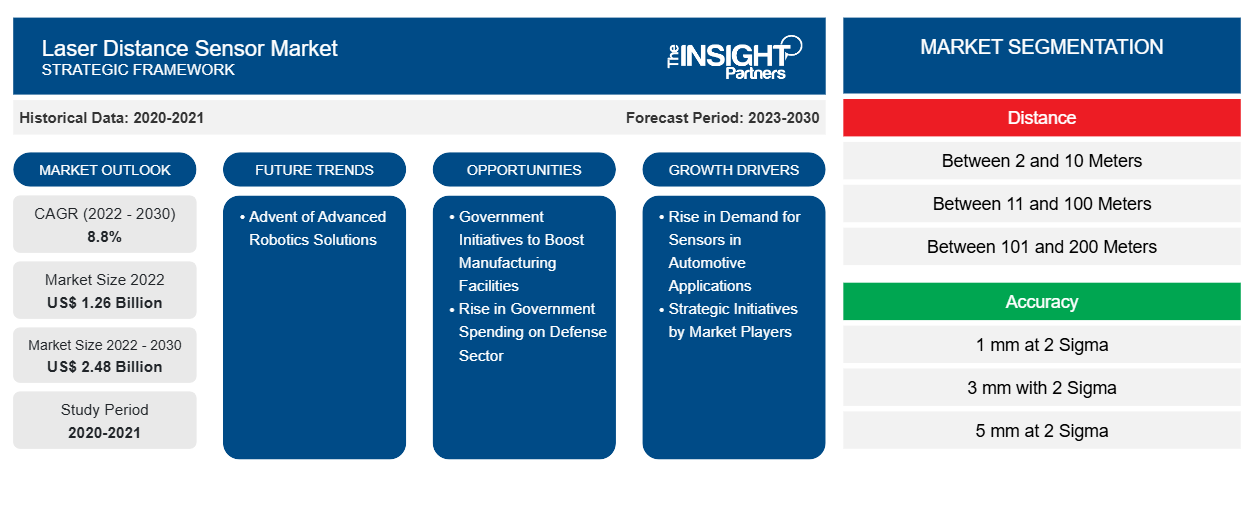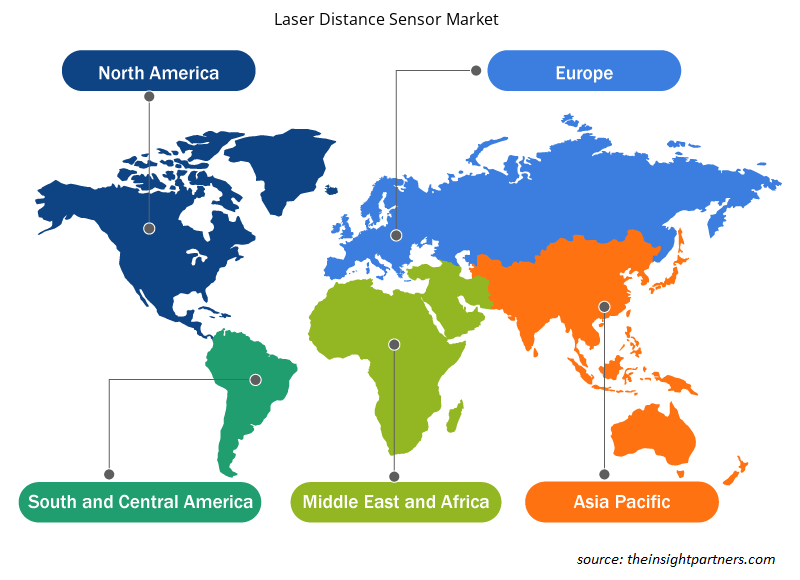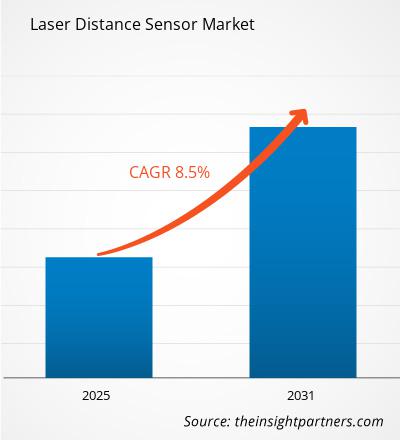レーザー距離センサー市場規模は2024年に21億4,000万米ドルと評価され、2031年には37億3,000万米ドルに達すると予測されています。また、2025年から2031年にかけて年平均成長率(CAGR)8.5%を記録すると予測されています。高度なロボットソリューションの登場は、今後も重要な市場トレンドであり続けるでしょう。2025年から2031年にかけて、年平均成長率(CAGR)は8.5%と予測されます。高度なロボットソリューションの登場は、今後も主要な市場トレンドであり続けるでしょう。
レーザー距離センサー市場分析
政府による製造施設の自動化への関心の高まりは、レーザー距離センサーの需要を生み出しています。高度なセンシングアプリケーションは、製造施設の運用効率の向上に役立ちます。したがって、製造業を後押しするための政府投資の増加は、レーザー距離センサー市場の成長を促進します。さらに、自動車産業はレーザー距離センサーの主要な用途の一つです。自動車への先進技術の統合は、レーザー距離センサー市場を牽引しています。
レーザー距離センサー市場の概要
レーザー距離センサーは、レーザー光線を用いて物体間の距離を測定するコンポーネントです。これらのセンサーは距離を測定し、長距離でも正確な測定を可能にします。ToF(Time-of-Flight)原理に基づいて動作し、センサーはレーザー光線を発射し、その反射光を受信します。レーザー光線の送信から受信までの時間差を利用して、レーザー距離センサーは距離を測定します。ToF (ToF )の原理では、センサーがレーザービームを発射し、その反射光を受信します。レーザービームの送信と受信の間に経過する時間によって、レーザー距離の測定精度が向上します。
要件に合わせてレポートをカスタマイズ
このレポートの一部、国レベルの分析、Excelデータパックなど、あらゆるレポートを無料でカスタマイズできます。また、スタートアップや大学向けのお得なオファーや割引もご利用いただけます。
レーザー距離センサー市場:戦略的洞察

- このレポートの主要な市場動向を入手してください。この無料サンプルには、市場動向から見積もりや予測に至るまでのデータ分析が含まれます。
レーザー距離センサー市場の推進要因と機会
自動車用途におけるセンサー需要の増加
自動車産業は、技術開発の進展に伴い急速に成長しています。車両は、自動運転システムがドライバーを支援し、安全性、快適性、利便性を向上させるために、効果的なセンシング技術に依存しています。レーザー距離センサーは、自動運転車において、位置特定、障害物検知、物体のピックアップや配置など、様々な目的で使用されています。この技術は、物体の検出に役立ち、3次元空間における位置と動きに関する情報を提供します。また、物体のサイズ、形状、向きを検出することで、物体の識別にも役立ちます。
自動車業界における継続的な変革は、先進運転支援システム(ADAS)と光検出・測距(LiDAR )の需要を喚起しています。ADASおよびLiDARアプリケーションにおいて、高精度と異種信号冗長性に対する要件がますます重視されるようになり、レーザー距離センサーの需要が高まっています。多くの自動車メーカーがADASおよびLiDAR技術に注力しています。このように、自動車メーカーによるADAS技術の採用は、車両の高度な自動化に必要な信頼性を高めるためのレーザー距離センサーの需要を生み出し、レーザー距離センサー市場の成長をさらに促進します。
製造施設の強化に向けた政府の取り組み
インダストリー4.0は、企業による製品の製造、加工、流通の方法を変革し、ヒューマンエラーのリスクを最小限に抑え、安全な環境を提供することで製品品質の向上に注力しています。インダストリー4.0の導入拡大を受け、各国政府は製造業のさらなる発展を目指して投資を行っています。例えば、ジョンソン・エンド・ジョンソンは2025年3月、今後4年間で米国における製造、研究開発、技術開発に550億米ドルを新たに投資すると発表しました。さらに、「Make in India」や「Made in China 2025」といった取り組みは、市場関係者が製造能力を拡大し、生産量を増加させ、最終製品の効率を高めるための先進技術を導入するのを支援しています。工業化の進展は、自動車、食品・飲料、化学など、様々な業界で新たな製造施設の建設を促進し、特定のタスクを遂行するための自動化ソリューションの必要性をさらに高めています。レーザー距離センサーは、製造プロセスの改善とエラーフリー化のために、リアルタイムで高精度な測定を提供する上で重要な役割を果たします。新たに建設された自動化製造施設は、品質管理、生産性、そして全体的なコスト効率の向上に必要な部品の需要を生み出します。そのため、政府が製造施設の増強と自動化の統合に注力することで、レーザー距離センサー市場の成長に有利な機会が生まれると予想されます。
レーザー距離センサー市場レポートのセグメンテーション分析
レーザー距離センサー市場分析の導出に貢献した主なセグメントは、波長、電力範囲、およびエンドユーザーです。
- レーザー距離センサー市場は、波長に基づいて、200~650nm、651~1100nm、1101~3000nm、3001nm以上の4つに分類されます。2024年には、3001nm以上のセグメントが最大の市場シェアを占めました。
- レーザー距離センサー市場は、出力範囲に基づいて、1mW未満、1~100mW、101mW~500mW、500mW超に分類されます。2024年には、101mW~500mWセグメントが最大の市場シェアを占めました。
- 業界別に見ると、市場は製造業、建設業、自動車・ロボット工学、航空宇宙・防衛、地理空間産業、環境モニタリング、その他に分類されています。2024年には、自動車・ロボット工学分野がレーザー距離センサー市場において最大のシェアを占めました。
レーザー距離センサー市場シェアの地域別分析
- レーザー距離センサー市場は、北米、ヨーロッパ、アジア太平洋地域(APAC)、中東・アフリカ地域(MEA)、中南米の5つの主要地域に区分されています。2024年にはアジア太平洋地域が市場を席巻し、北米とヨーロッパがそれに続きます。
- アジア太平洋地域では、インド、中国、日本などの国々における産業オートメーションの増加が、市場の成長を牽引する主な要因となっています。製造、物流、自動車など、さまざまな分野で産業オートメーションが広く採用されていることは、レーザー距離センサー市場の大きな推進力となっています。レーザー距離センサーは、正確で信頼性の高い距離測定を提供し、精密な位置決め、物体検知、衝突回避を可能にすることで、オートメーションにおいて重要な役割を果たしています。2024年7月、中国の自動車メーカーであるBYDは、タイに初の電気自動車工場を開設し、東南アジアへの大きな進出を示しました。この急速に成長する市場において、同社は主要プレーヤーとしての地位を確立しています。BYDの工場は、政府の補助金や税制優遇措置に支えられ、タイに工場を建設している中国のEVメーカーによる14億4千万米ドルを超える投資の波の一部です。この大規模な注文は、BYDが高度なオートメーション技術を活用し、製造プロセスにおける運用効率を高めることに注力していることを浮き彫りにしています。
レーザー距離センサー市場の地域別分析
Insight Partnersのアナリストは、予測期間全体を通してレーザー距離センサー市場に影響を与える地域的なトレンドと要因を詳細に解説しています。このセクションでは、北米、ヨーロッパ、アジア太平洋、中東・アフリカ、中南米におけるレーザー距離センサー市場のセグメントと地域についても解説します。

- レーザー距離センサー市場の地域別データを入手
レーザー距離センサー市場レポートのスコープ
| レポート属性 | 詳細 |
|---|---|
| 2024年の市場規模 | 21億4000万米ドル |
| 2031年までの市場規模 | 37億3000万米ドル |
| 世界のCAGR(2025年~2031年) | 8.5% |
| 履歴データ | 2021-2023 |
| 予測期間 | 2025~2031年 |
| 対象セグメント | 波長別
|
| 対象地域と国 | 北米
|
| 市場リーダーと主要企業の概要 |
|
レーザー距離センサー市場のプレーヤー密度:ビジネスダイナミクスへの影響を理解する
レーザー距離センサー市場は、消費者の嗜好の変化、技術の進歩、製品メリットへの認知度の向上といった要因によるエンドユーザー需要の増加に牽引され、急速に成長しています。需要が高まるにつれ、企業は製品ラインナップの拡充、消費者ニーズへの対応、そして新たなトレンドの活用を進めており、これが市場の成長をさらに加速させています。
市場プレーヤー密度とは、特定の市場または業界内で事業を展開する企業または会社の分布を指します。これは、特定の市場空間における競合企業(市場プレーヤー)の数が、その市場規模または市場価値全体と比較してどれだけ多いかを示します。
レーザー距離センサー市場で事業を展開している主要企業は次のとおりです。
- シックAG
- ifmエレクトロニック株式会社
- ヘキサゴンAB
- iC-Haus GmbH
- 浜松ホトニクス株式会社
- ロイズ・エレクトロニック社
免責事項:上記の企業は、特定の順序でランク付けされているわけではありません。

- レーザー距離センサー市場のトップキープレーヤーの概要を入手
レーザー距離センサー市場のニュースと最近の動向
レーザー距離センサー市場は、主要な企業出版物、協会データ、データベースなどを含む一次調査および二次調査に基づく定性・定量データの収集によって評価されます。レーザー距離センサー市場における動向のいくつかを以下に示します。
- ドイツの有力センサー・オートメーション企業であるifm Electronic GmbHは、インドネシアにおける事業展開を拡大し、同国の「Making Indonesia 4.0」構想の成功に貢献しています。同社は2022年10月10日にインドネシア子会社PT ifm electronic Indonesiaを設立しました。その後、2023年8月3日には、ジャカルタのセントラル・スナヤンIIにオフィスを正式に開設し、盛大な開所式を行いました。この動きは、インドネシア市場への積極的な関与と、同国の産業振興への取り組み支援への同社のコミットメントを強調するものです。(出典:ifm Electronic GmbH、プレスリリース、2023年8月)
- センサー、エンコーダ、計測機器、自動画像処理コンポーネントのリーディングメーカーであるバウマーグループは、メキシコに新たな子会社を設立しました。メキシコのサンティアゴ・デ・ケレタロに新オフィスを開設したことで、バウマーは世界19カ国に拠点を構え、39の開発センター、生産拠点、販売拠点を運営することになります。
(出典:バウマーグループ、プレスリリース、2025年1月)
レーザー距離センサー市場レポートの対象範囲と成果物
「レーザー距離センサー市場の規模と予測(2021〜2031年)」では、以下の分野を網羅した市場の詳細な分析を提供しています。
- レーザー距離センサー市場の規模と予測(世界、地域、国レベルで)
- レーザー距離センサー市場の動向、および推進要因、制約、主要な機会などの市場動向
- 詳細なPEST分析とSWOT分析
- 主要な市場動向、世界および地域の枠組み、主要プレーヤー、規制、最近の市場動向を網羅したレーザー距離センサー市場分析
- レーザー距離センサー市場の市場集中、ヒートマップ分析、主要プレーヤー、最近の動向を網羅した業界の展望と競争分析
- 詳細な企業プロフィール
- 過去2年間の分析、基準年、CAGRによる予測(7年間)
- PEST分析とSWOT分析
- 市場規模価値/数量 - 世界、地域、国
- 業界と競争環境
- Excel データセット
最新レポート
関連レポート
お客様の声
購入理由
- 情報に基づいた意思決定
- 市場動向の理解
- 競合分析
- 顧客インサイト
- 市場予測
- リスク軽減
- 戦略計画
- 投資の正当性
- 新興市場の特定
- マーケティング戦略の強化
- 業務効率の向上
- 規制動向への対応




















 無料サンプルを入手 - レーザー距離センサー市場
無料サンプルを入手 - レーザー距離センサー市場